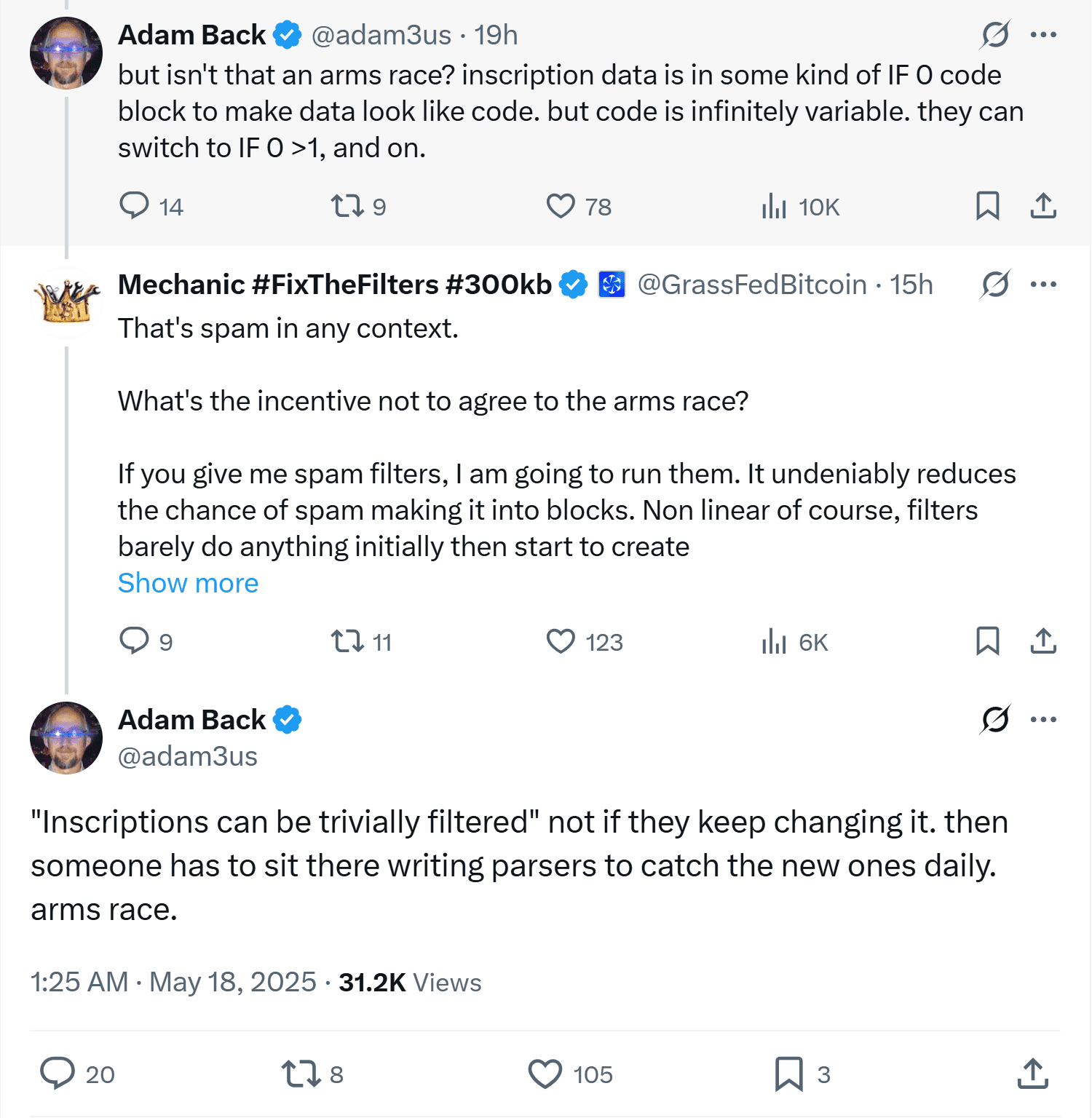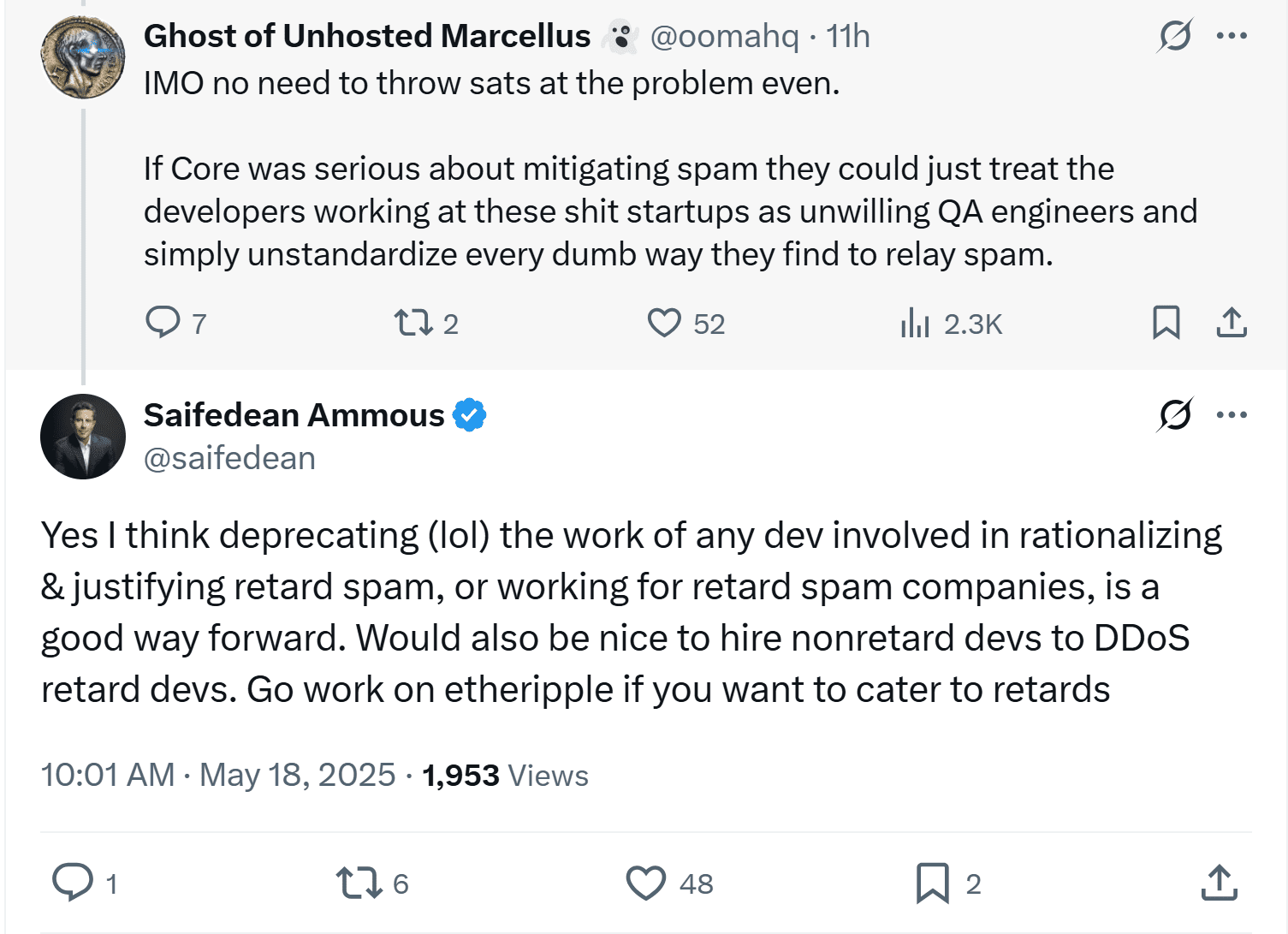The debate surrounding spam inscriptions on the Bitcoin network continues, with prominent voices like Saifedean Ammous, author of “The Bitcoin Standard,” weighing in. Ammous has suggested he’d contribute funds to support a full-time developer dedicated to making Bitcoin spamming more difficult and expensive.
This proposal arose from a discussion initiated by the developer GrassFedBitcoin, who advocated for the integration of pull request #28408 into Bitcoin Core. This pull request would give node operators greater ability to filter inscriptions.
GrassFedBitcoin argues that the current lack of inscription filtering tools leads to blockchain bloat and undermines Bitcoin’s primary function as a monetary protocol. He emphasized that node operators generally don’t want to relay inscriptions and that past justifications for OP_RETURN limit increases were based on flawed assumptions.
Adam Back, CEO of Blockstream, countered this proposal, describing inscription filtering as an “arms race.” He pointed out that spam data embedded in Bitcoin transactions can be endlessly modified, requiring constant updates to filtering tools.

Ammous’s Stance: Comparing Bitcoin Spam to Email Spam
Ammous draws a parallel between Bitcoin spam and email spam, noting that society continuously combats the latter without abandoning the email system altogether.
“It’s not easy, but it’s worth trying to help bankrupt the spammers faster,” Ammous stated. He clarifies that fighting spam isn’t censorship, emphasizing that node operators already reject invalid transactions.
“So a node runner looking to remove retards’ spam is no less valid than retards’ spam,” he added.
This conversation has ignited widespread discussion within the Bitcoin community. One participant suggested that Core developers treat employees at spam-coding startups as “unwilling QA engineers” and actively unstandardize the techniques they employ.
Ammous further proposed “deprecating” the work of developers building spam tools and even hiring external coders to overwhelm these systems.

Understanding Bitcoin Inscriptions and Their Impact
Bitcoin inscriptions, also known as Ordinals, allow users to inscribe data, such as text, images, or even code, directly onto individual satoshis (the smallest unit of Bitcoin). While proponents see this as a way to expand Bitcoin’s functionality, others worry about the potential for network congestion and increased transaction fees.
The debate highlights the ongoing tensions within the Bitcoin community regarding the network’s intended use and scalability. As inscriptions continue to fill blocks, calls for technical solutions and criticisms of those who defend spam are growing louder.
The Technical Implications of Inscriptions: Block Size and Network Congestion
A February 4th report from Mempool Research indicated that the increasing adoption of inscriptions could push the Bitcoin network’s average block size to as high as 4 megabytes (MB) per block, significantly exceeding the current average.
Bitcoin’s average block size currently hovers around 1.5 MB. Larger block sizes can lead to increased network congestion, slower transaction confirmation times, and higher transaction fees, particularly during periods of peak activity.
Potential Solutions and Countermeasures
The Bitcoin community is exploring various potential solutions to mitigate the negative impacts of inscriptions. These include:
- Inscription Filtering: As proposed by GrassFedBitcoin, implementing tools that allow node operators to filter out inscription transactions.
- Transaction Fee Adjustments: Exploring dynamic transaction fee mechanisms that prioritize transactions based on data size and type.
- Layer-2 Solutions: Leveraging Layer-2 scaling solutions like the Lightning Network to offload smaller transactions from the main Bitcoin blockchain.
- Optimizing Data Storage: Improving the efficiency of data storage on the Bitcoin blockchain to reduce the size of inscriptions.
The Broader Debate: Bitcoin as Money vs. Bitcoin as a Platform
The controversy surrounding Bitcoin inscriptions underscores a fundamental debate within the Bitcoin community: Should Bitcoin primarily serve as a decentralized digital currency (a store of value and medium of exchange), or should it evolve into a more versatile platform capable of supporting a wider range of applications?
Those who prioritize Bitcoin’s role as money tend to view inscriptions as unnecessary and potentially harmful, arguing that they detract from the network’s core purpose. On the other hand, proponents of Bitcoin as a platform believe that inscriptions can unlock new and innovative use cases, expanding Bitcoin’s reach and utility.
Conclusion: Navigating the Future of Bitcoin
The discussion surrounding Bitcoin inscriptions is likely to continue as the Bitcoin ecosystem evolves. Finding a balance between innovation and preserving Bitcoin’s core principles will be crucial for the long-term success and sustainability of the network. The perspectives of individuals like Saifedean Ammous and Adam Back, along with the efforts of developers and researchers, will play a vital role in shaping the future of Bitcoin.